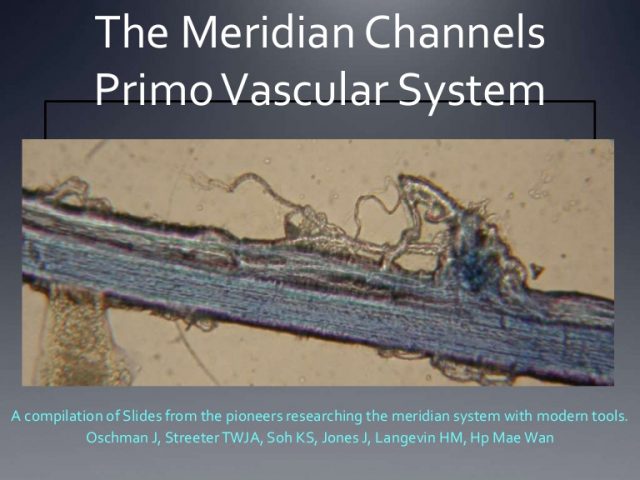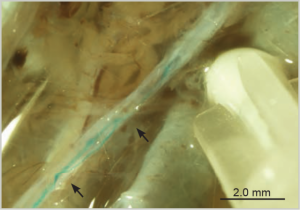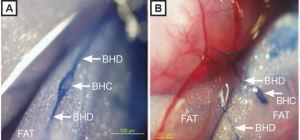 Bong-Han Kim was horn in 1916, and graduated from the College of Medicine Seoul National University in 1941. He was an Associate Professor at Pyung Yang Medical School, Physiology Laboratory, when he announced his discovery of anatomical structures corresponding to acupuncture points and meridians, named the Bonghan System/Primo Vascular System, at the Symposium at the Pyung Yang Medical School on August 18, 1961, which he published in 1962. There was no description of the method how the structures were found or identified.
Bong-Han Kim was horn in 1916, and graduated from the College of Medicine Seoul National University in 1941. He was an Associate Professor at Pyung Yang Medical School, Physiology Laboratory, when he announced his discovery of anatomical structures corresponding to acupuncture points and meridians, named the Bonghan System/Primo Vascular System, at the Symposium at the Pyung Yang Medical School on August 18, 1961, which he published in 1962. There was no description of the method how the structures were found or identified.
The epoch-making discovery was made sometime between 1962 and 30 November 1963, when he published his second report as the director of the Kyung-Rak Research Institute (KRI). This Institute was known to be a National Institute of North Korea and was probably established in this period. The publications in the name of Bong-Han Kim were reports on the collective works of researchers in this Institute. Unlike journal papers, these reports did not have “Method” or “Materials” sections. In that paper, which was the second among a series of five articles with the name of Bong-Han Kim, he mentioned that he found the most important material, a blue tracing dye which revealed not only acupuncture meridians hut their extensions into the body. Thereafter, his team established the existence of a new circulatory system running throughout an animal’s body.
For some unknown reasons, the KRI was closed around 1966, and no official or any reliable sources gave any hint on the fate of Bong-Han Kim and other researchers of the Institute. Until to the present time, no traces have been found of the KRI or of Kim and his team.
The historical discovery of Bong-Han Kim in 1963 was widely publicized in daily newspapers of China, Japan, and Russia, and many teams tried to reproduce his results. Strangely enough, there was no record that any of them requested the mysterious staining blue dye of Bong-Han Kim, which was essential to confirming his results. It is not surprising at all that no one was able to either prove or disprove his claims.
Only one Japanese researcher, Satoru Fujiwara, who was an Assistant Professor of Anatomy at Osaka City University, was stubborn enough to observe the primo vascular system (PVS) in blood vessels and on the surface of organs of rabbits. He produced one journal article in 1967 and published a hook, “Discovery of Acupuncture Meridian”, both in Japanese. He recalled that it took nearly 6 months to find the (PVS) in his own way without knowing Kim’s secret blue dye. His results were limited only to a few subsystems of the whole PVS, and he could not continue his research as people in Japan were sceptical of his pursuit after Kim’s fall in North Korea.
A breakthrough occurred in November 2008 with the discovery of the Trypan blue technique by BC Lee, with which the weblike network of the PVS was observed in the omentum of a rat and in adipose tissue.
The most striking progress was the discovery of the PVS around cancer tissue with the Trypan blue technique, which attracted much attention from cancer researchers.
Another great leap was the finding of the PVS floating in cerebrospinal fluid in the brain ventricle and the central canal of the spinal cord. This PVS can be visualized by injecting fluorescent nanoparticles into the lateral ventricle of the brain of a rat.
In September 17-18, an International Symposium of Primo Vascular System (ISPS 2010) with special topics on cancer, regeneration, and acupuncture was held in Jecheon, Korea. The topics suggested that the PVS was deeply related to cancer, regeneration / stem cells, and imaging of the acupuncture meridian. Based upon the detection techniques developed by the SNU group, applied research to gain a basic understanding of the PVS can be started, which is the second phase of the PVS research.
Bong-Han Kim’s published five articles in Korean in the Journal of Jo Sun Medicine from 1962 to 1965. The subjects of articles are about the studies on the reality of acupuncture meridian, the Kyungrak system, and the Sanal theory (a kind of microcell whose function was similar to embryonic-like stem cells in modern terminology).
There were five articles published in the name of Bong-Han Kim. They were not research articles in a proper form but a kind of report of the Institute of Acupuncture Meridians which was a national research institute of the North Korean government, and of which Kim was the Director.
Kyungrak System (Primo Vascular System)
A series of experiments on the Kyungrak system (primo vascular system (PVS)) show that the PVS is another, independent functional-morphological system.
- The PVS consists of the primo nodes (Bonghan corpuscles) and the primo vessels (Bonghan ducts) linking them.
The primo nodes exist not only in the skin but arc widely distributed in the profunda of the organism as well.
This coincides also with the experiences gained in the clinical acupuncture.
In structure, however, the primo node in the skin (superficial primo node) is different from the profound primo node deep in the body.
The superficial primo node consists of the outer layer of smooth muscles and the inner substance made of various cells.
It is considered that this muscle layer is important in sending secretion to the primo vessel.
It is also considered that there are various kinds of cells in the inner substance and they perform the secretory function.
- The primo vessel has two forms of existence.
One of the forms of its existence is that it runs inside the blood vessel or the lymphatic vessel and the other is that it runs outside the vessel.
The intravascular primo vessel and the cxtravascular primo vessel take different directions from each other, but there is no difference between them in structure.
The primo vessel comprises bundles of the primo lumens.
The contents of the primo vessel are entirely different from those of the blood and lymphatic vessels. When stained with acridine orange, the primo vessel brightly fluoresces in yellowish green.
This also clearly distinguishes the primo vessel from other tissues.
- Primo fluid circulates in the PVS.
This has been substantiated by the method of dye injection into the primo node and the primo vessel and by the use of radioactive tracers.
The speed of its circulation is slower than that of the blood, and is much slower in the extravascular primo vessel.
Circulation in the intravascular primo vessel is considered to be maintained by the heart beat as is the case with the blood and lymph circulation. In other words, the circulation of the primo fluid is, it is considered, caused by the differences of pressure created around it, since the primo vessel lies in the blood current.
The contractile action of the smooth muscles of the outer layer of the primo node is believed to play a definite role in the circulation of the primo fluid in the system of extravascular primo vessels.
- The primo node has unique bioelectrical activity.
A series of similar changes of electric potential are observed in the primo node even when various electrodes and induction systems are applied to it. These changes of electric potential arc connected with the action of the living body, particularly with the action of the PVS.
The electrogram of PVS directly induced from the primo node is different from the various electric changes so far induced from the skin.
Current State of Research on the Primo Vascular System

Since the extensive reinvestigation of the Bong-Han Theory began in the year 2002, until 2008, essentially only one laboratory at Seoul National University (SNU) was involved. Then, suddenly six or so teams in Korea, three teams in China, one in Kazachstan, and three teams in USA started some experiments on the primo vascular system (PVS) in 2009 and 2010. Many more researchers throughout the world showed keen interest in the PVS, and the International Symposium on the PVS, with special topics on cancer, regeneration, and acupuncture, was held in September 2010. At this symposium, the International Society on PVS (ISPVS) was founded.
A major step in the methodology was the discovery in the year 2008 of the Trypan blue technique for the specific visualization of the PVS. Before this, the SNU group was groping its way searching for the PVS in various organs. With the Trypan blue technique, the PVS was found around cancer tissues, in adipose tissues, and in brain ventricles.
The places where the PVS was observed: nerve system, cardio-vascular system, lymphatic system, fascia in the abdominal cavity, adipose tissue, generative system (testis), skin and abdominal wall, primo fluid and microcells, egg vitelline membrane, and cancer.
Kim found a mysterious blue dye that flowed in the primo vessel to reveal the entire network in the body. He mentioned its use in many places, but did not give any information on either its substance or the procedure for using it. This is the most essential key element to the discovery of the PVS without which it is extremely difficult to observe or identify the PVS. He also used radioisotopes mainly to demonstrate the circulatory function of the PVS (46, 471 and to trace the flow of primo microcells 35J).
Without knowing the substance and the method of the blue dye, the SNU group tried various dyes and obtained partially fruitful results with Janus Green B |9], Alcian blue [10, 31], and Trypan blue [18]. Among these, Trypan blue was the most useful because it specifically visualizes the PVS among lymph vessels, blood vessels, fascia, nerves, muscles, and fat tissues.
More resources on the subject :
- https://en.m.wikipedia.org/wiki/Kim_Bong-han
- Primo Vascular System: A Unique Biological System Shifting a Medical Paradigm
- Primo-Vascular System as Presented by Bong Han Kim
- Open Access Articles- Top Results for Kim Bong-han
- Technical Challenges in Current Primo Vascular System Research and Potential Solutions
- A New Organ that Korean Discovered: the Bonghan System/Primo Vascular System 12 – Vol. 42 No. 4 The Journal of Korean-American Scientists and Engineers Association
Books :
- On the Kyungrak system
- Great Discovery in Biology and Medicine: Substance of Kyungrak
- The Primo Vascular System: Its Role in Cancer and Regeneration
- Kyungrak System and Theory Of Sanal: Proceedings of the Academy of Kyungrak of the DPRK, 1965 No.2

